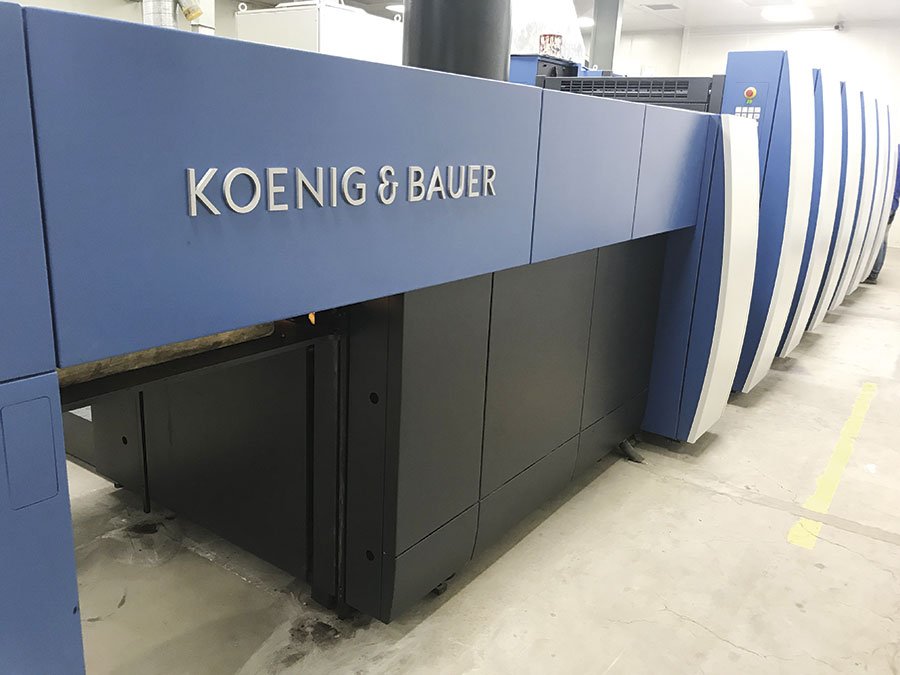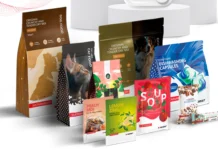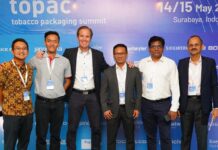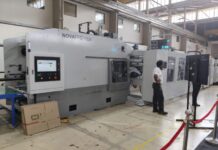White Print O Pack began producing monocartons in Paonta Sahib, Himachal Pradesh over 20 years ago. Its first customer, Mankind Pharma, has remained a major client over the years and this helped the company add a second packaging plant in 2008 in Baddi. White is a longtime K&B offset press user with three Rapidas at the Baddi plant. “It’s easier to work with three printing presses from the same manufacturer. It saves a lot of time and cost on the servicing of these presses. The spares are also similar for all the three presses. Moreover, we don’t have to spend time waiting for engineers as one can pretty effectively handle all the three machines,” says Amit Gera, partner at White Print O Pack.
Of the three K&B Rapida sheetfed offset presses, two are second-hand – a 4-color 2001 model imported from Belgium and the other a 6-color press imported from Australia, which is a 2004 model. Gera says that although there are occasional electrical problems with these presses, there haven’t been any mechanical issues so far.
White Print O Pack’s new K&B Rapida 75 Pro
In April 2019, the company installed its first new K&B Rapida, a 75PRO 5-color plus coater. “With the new Rapida press, there won’t be any electrical hiccups as the servo card system has been changed to a PLC system. A PLC circuit system suits Indian power conditions pretty well. With the new Rapida in production, the electric spikes should not be a trouble anymore,” says Gera.
The new 5-color plus coater press is meant for producing monocartons with a rated speed of 15,000 sheets an hour, which is the speed that White was running it during our visit. The press automation including the user-friendly TouchTronic makes for much shorter makeready and gives access to all operating functions with a maximum of two taps on the touch screen.

Photo PSA
“As far as converting Bobst makes the most satisfactory machines in our experience. The presence of a Bobst in a packaging plant can effectively increase the production output. If you’ve got a Bobst, you’ve got everything! Of the two Bobst die-cutters, one is a 1984 refurbished machine that we purchased from Bobst India,” says Gera. The Bobst Novacut die-cutting machine at White Print O Pack is a 2014 model that was purchased brand new.
Pharma packaging becomes a volume game
On a monthly basis, White produces nearly 2 crore cartons a month with a value of Rs. 2 to 2.5 crores. White Print O Pack supplies cartons to Mankind Pharma, Galfa, Biocon and Nectar. The company also supplies to several pharma contract manufacturers in Baddi. “Pharma packaging, especially monocartons, has been simplified over the years.
Perviously, we used to print on metallized polyester laminated board (metpet). However, pharma companies have shifted from the premium folding boxboard (FBB) to white back and grey back boards. The substrate input has come down drastically and that has affected our overall profits. White back and grey back are the cheapest boards whereas FBB is a premium paperboard. This clearly shows that all the pharmaceutical companies are doing drastic cost-cutting although it may also have something to do with new government norms,” says Gera. With the margins squeezed in pharmaceutical packaging, Gera shares that the company may move to FMCG packaging in the future.
WHO-GMP compliance
According to recent market inputs, Gera says that contract manufacturing of pharma products may become more difficult. Rigid government norms and compliances with World Health Organization’s Good Manufacturing Practices (WHO-GMP) may put small contract manufacturers under pressure and might even eliminate contract manufacturing.
Under the WHO-GMP system, companies must ensure that pharmaceutical products are consistently produced and controlled according to quality standards and benchmarks. These are designed to minimize the risks of pharmaceutical production that cannot be eliminated through testing the finished product. Unexpected cross contamination, causing damage to health or even death, wrong labels on containers causing confusion, and even the wrong medicines reaching patients, or not enough or too much active ingredients resulting in ineffective treatment or adverse effects are all potential threats that are sought to being safeguarded by accurate packaging and labelling.
Baddi’s SEZ status to end in 2020
The SEZ or special economic zone status with tax benefits that Baddi enjoys is set to conclude in 2020. Home to many pharma manufacturing plants and R&D hubs in Baddi and nearby towns, one might see a change in the business demographics of the area. “Those who established their business on or before March 2010 have been reaping the benefits of this special status and will continue to do so till March 2020. The special status eliminated excise duties. We got 100% rebate on income tax for five years, which adds up to a huge amount. For big pharma companies, whose yearly turnover is around Rs. 100 crores, it adds up to a huge benefit.
“However, I don’t think the companies will move since setting up a unit in Baddi even today is much easier and more cost efficient in comparison to places like Chandigarh. Since Sikkim has also given special privileges, many new companies were established there before March 2018. The only competition we may have is from Jammu as it is still under SEZ and several companies are setting up their units there. Baddi is strategically located, close to Chandigarh and comparatively closer to Delhi. Hence, I am optimistic that this area will continue to flourish in the coming days,” Gera explains.
Drip-off effects in demand
Earlier, the company’s sales in terms of value were higher with the same volumes but with the use of inferior boards its margins have suffered. The investment in the brand new K&B Rapida 75PRO is aimed at increasing volumes while protecting its efficiencies and margins. In the coming year, White Print O Pack plans to invest in drip-off coating equipment as the demand for drip-off effects is currently quite strong according to Gera. “Our bottleneck is drip-off coating right now. We have only one machine for drip-off – a double color Heidelberg press – but we’re looking to invest more in this technology. We are aiming for a 10% growth in business in the upcoming financial year,” concludes Gera.











